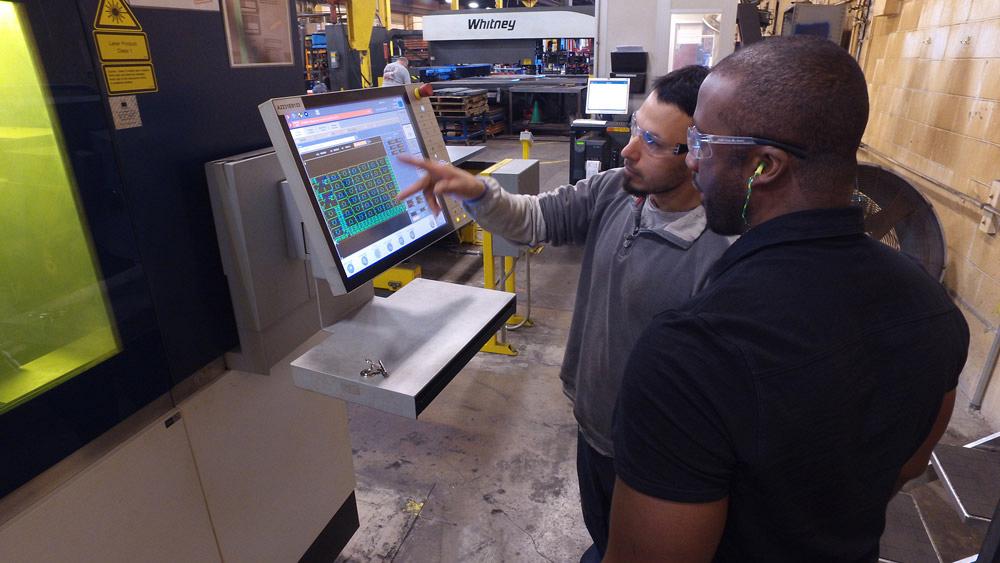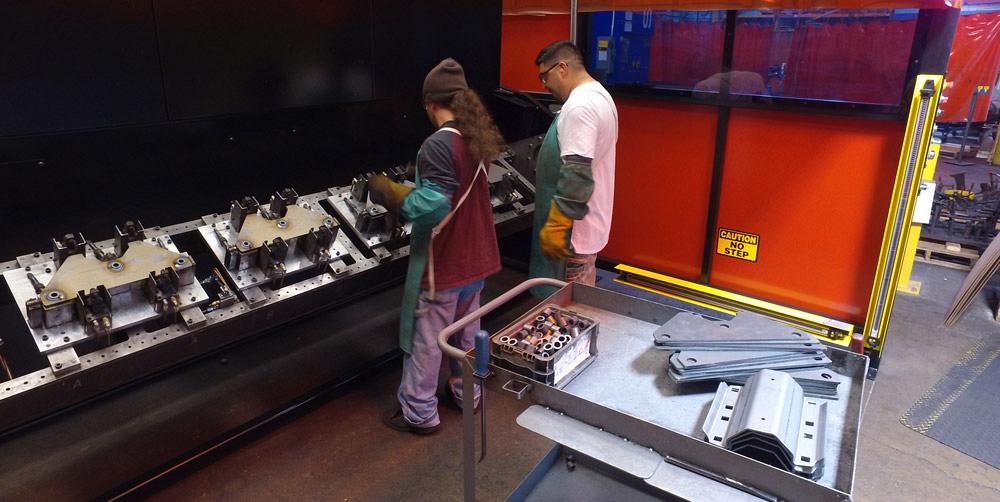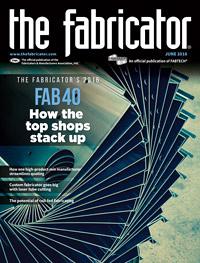Senior Editor
- FMA
- The Fabricator
- FABTECH
- Canadian Metalworking
Categories
- Additive Manufacturing
- Aluminum Welding
- Arc Welding
- Assembly and Joining
- Automation and Robotics
- Bending and Forming
- Consumables
- Cutting and Weld Prep
- Electric Vehicles
- En Español
- Finishing
- Hydroforming
- Laser Cutting
- Laser Welding
- Machining
- Manufacturing Software
- Materials Handling
- Metals/Materials
- Oxyfuel Cutting
- Plasma Cutting
- Power Tools
- Punching and Other Holemaking
- Roll Forming
- Safety
- Sawing
- Shearing
- Shop Management
- Testing and Measuring
- Tube and Pipe Fabrication
- Tube and Pipe Production
- Waterjet Cutting
Industry Directory
Webcasts
Podcasts
FAB 40
Advertise
Subscribe
Account Login
Search
Scaling up metal fabrication: In support of the front line
In support of the front line
- By Tim Heston
- June 15, 2016
- Article
- Shop Management
Earlier this year General Sheet Metal Works should have been in a world of hurt. In early spring, as cold weather stubbornly returned to South Bend, Ind., dozens of key employees couldn’t come to work. Many were sick; some were caring for loved ones.
Taylor Lewis, vice president and chief operating officer, remembered speaking with a material handler newly assigned to move material between operations. That day so many had called in sick, the material handler was doing the job of three people.
“I asked her how things were going,” Lewis recalled. “She told me, ‘I can do it—barely, but everything’s OK. It’s working.’ She was really proud that it was working, too. She could do the job of three people because the system now made sense.”
That system is a new material handling process that relies on carefully defined “circuits,” similar to bus routes, for handling material throughout the fabricator’s two facilities in South Bend—but that’s just the tip of the iceberg. Supporting this and all other improvement initiatives is a new organizational structure that took three years to develop.
It’s now paying dividends. The 300-employee custom fabricator has had explosive growth in recent years. First-quarter revenues were up more than 17 percent from Q1 2015. And overall revenues for 2015 were up 35 percent over 2014. For a $70 million operation, that’s especially significant.
The fabricator has never been heavily into oil and gas or mining equipment. It does produce components for grain storage, but it has never been deep into agricultural equipment. “We’ve been lucky to dodge all of it,” said President John Axelberg. “We weren’t affected by the industry collapses that other fabricators experienced.”
The new (and still evolving) company structure has allowed employees to absorb additional growth—spurred by new orders in industries like commercial solar, lawn and garden, and automotive—without breaking a sweat. And it has made scaling up the business easier. How, exactly? It goes back to everyone having a clearly defined set of job responsibilities with standardized work. Most important, the front line gets the support it needs to get the job done right.
Problems With “Get ’er Done”
Five years ago employees worked 10-hour shifts five days a week and sometimes put in two more eight-hour shifts on the weekend. Overtime mounted during periods of peak demand. People were exhausted, morale was low. But at the time, it was thought that was just the reality of working at a custom fabricator, especially one like GSMW with its “get ’er done” goal of on-time delivery.
Like almost every company in this business, the fabricator had problems recruiting talent and finding skilled workers. Year after year Axelberg attended industry events and heard the same griping about finding good people.
Eventually, though, Axelberg and Lewis discovered that griping about skilled labor issues was really a symptom of a larger problem. GSMW lacked structure, standardization, and a clear trajectory for individual growth and development. Nothing was formalized; everything was fluid.
Many small and medium-sized shops tout this informal way of doing business as a good thing. After all, this is high-product-mix manufacturing. People need to be flexible to get the job done. Who wants a burdensome bureaucracy?
But according to Lewis, what makes bureaucracies burdensome isn’t formalized job descriptions and documented procedures; it’s the fact that those descriptions and procedures don’t support what really drives the business.
So the leadership team looked inward and redefined their business model to one that focused on more than just manufacturing efficiency. The ultimate goal was to protect its customers’ brands. (For more on this, see the March 2014 FABRICATOR article, “A new business model, a new structure, a new business,” archived at thefabricator.com.)
This mission spurred a new organizational structure designed to support the front line. A press brake operator works under a department supervisor, who in turn reports to the shift manager, whose goal is to optimize production. But that brake operator also has the support of a bending machinery technician, who knows each press brake inside and out and keeps the machines in top-running condition. That technician doesn’t work for production, but instead is part of the Manufacturing Technology Performance Team, which reports to the Facilities Group, which manages general facility and machine-specific maintenance and performance.
Also supporting that brake operator is a bending engineer, who leads the team, collaborating on manufacturing challenges and process improvement ideas.
Front-line workers now have people dedicated to help make their jobs easier. When an operator has a problem or question about machine performance, he turns to the department’s dedicated machinery technician. When he has a manufacturing question, he turns to the department’s dedicated engineer.
Don’t Eat Your Seed Corn
If a novice gets a job at a custom fabricator, he or she probably can expect to spend their first weeks engaged in on-the-job training with a supervisor. But at GSMW, managers saw inherent problems with this. First, the supervisors still had production goals to meet. Yes, they showed people what to do, but often they showed rookies so quickly that they learned only by rote. They really didn’t learn how to operate the machine.
“I remember watching [supervisors] show new people which buttons to push on the CNC, and their hands moved so quickly, you couldn’t even see them,” Axelberg said. “Of course, these new people would never learn.”
Second, no one was ever taught how to teach. As Lewis explained, some people learn kinesthetically, by having someone physically guiding their hands to certain positions or buttons. Others are auditory learners: Describe what to do clearly and precisely, and they’ll understand. Still others learn visually: Show them and they’ll remember.
So the company created another position: the certified machine skills instructor, or CMSI. These people must have two qualifications: First, they need to be the most skilled operators in their area; second, they must be motivated to teach and support others. Without such motivation, the best operator in the world probably couldn’t convey the basics to a novice. Once selected, the CMSI is trained on how to identify and accommodate different learning styles.
“These people go from machine to machine, employee to employee, to ensure we can bring them up to speed as quickly as possible,” Lewis said.
These trainers report not to production supervisors, but instead to the training and development manager, who judges their performance based on how well operators progress through different levels of expertise: Level I (the baseline required for all permanent employees), Level II, and Level III (expert level).
No one at the company had a problem with the second qualification, being motivated to help others, but the first spurred serious debate. Why on earth take top-producing operators away from production?
“There was resistance to that,” Lewis said. “Many wanted to keep them in production. But I said, ‘Look, you’re eating your seed corn here, especially if they want to advance.’”
That’s a metaphor tailored for a fabricator in the Hoosier State. Take away seed corn, and there is no crop the following year. You kill the farm. A fabricator’s seed corn is the CMSI, best-in-class operators who in turn “seed” their knowledge to others, so that they too can one day become best-in-class operators.
Moreover, the rookies being trained aren’t practicing; they’re making production parts. “That’s why it’s so important that CMSIs be the best operators we have,” Lewis said. “You can’t compromise production or you penalize either yourself or your customer.”
Standardization
Specific training requirements for each level have changed over the years. For instance, operators once needed to know how to program a press brake at the machine.
“Now, programming at the machine is against policy,” Axelberg said, adding that all of the company’s TRUMPF press brakes are now programmed and simulated offline. Spending time programming at the machine was a needed skill in the past; now it just hinders productivity.
This training policy wouldn’t work as well if the press brake department had a variety of machines with different controls and capabilities. If only one or two brakes could be programmed offline, then of course operators would need to learn how to program at the machine.
To this end, GSMW is also pushing toward technology standardization. This helps not only with training, but also machine maintenance. Every press brake at the shop is of the same brand name and has the same control interface. The same is true with the lasers and punch presses, welding machines, and more.
This dovetails into the company’s broader initiative of carefully defining and spelling out standard work for every position on the org chart. As Lewis explained, standard work represents the “supporting structure” for the job. Rather than limiting a person’s job responsibilities, standard work sets the baseline—or, as Lewis put it, “those things on which other levels of the organization absolutely rely on, day in and day out.”
She added that the job description and its standard work are tied to a position on the org chart, not a person. If a person calls in sick, others can refer to that standard work to know what needs to get done, to keep the work flowing.
When dozens called in sick earlier this year, Lewis conceded that people felt the pressure. But because much of the standard work was documented, and processes were in place to keep the work flowing, people weren’t anxious.
“When people aren’t anxious, they think more clearly,” she said, “and they think more creatively. When the pressure was on, people were excited because the processes were holding. We were running really tight, but it was working. They weren’t fighting fires. It wasn’t falling apart.”
Material Flow and Scheduling
Custom fabricators aren’t strangers to fighting those metaphorical fires. When you boil it all down, though, those fires come from only a handful of sparks. One is lack of employee training and support, which leads to operator errors and miscommunication. GSMW overcame this with defined processes, engineering and machine maintenance support, clearly defined tasks associated with each position, and individualized training with dedicated instructors.
Still, even if machines run smoothly and well-trained operators know exactly what to do, they still can’t produce products without material. Too often employees were waiting for material to be delivered, as fork trucks crisscrossed GSMW’s two adjacent plants. It wasn’t ideal, and company leaders could have considered this the nature of the beast. After all, the oldest section of one plant was built back in 1924. This could have been seen as a problem that would be overcome when the fabricator leaves its current plants and moves into a newly built facility later this year. (Editor’s note: For more on this, refer to the March 2014 article available at thefabricator.com.)
But considering all of its growth, GSMW really couldn’t wait. Lewis, along with Kathy Crimmins, director of cultural development, led a cross-functional team to identify material flow problems and, ultimately, develop those material flow circuits, which make the best of a less-than-ideal shop layout.
If material needs to be sent to a certain process, it’s staged at a kind of “bus stop” on the circuit, where it’s picked up and delivered via the defined route. Fork trucks no longer drive about in a spaghetti-diagram mess. Managers are even using some of the material handling circuit concepts to plan the layout for the new South Bend plant, slated to open in December.
Continual changes in scheduling can also (again, metaphorically) create the sparks for a lot of firefighting. To overcome this, GSMW implemented what it calls “adaptive scheduling.” Jobs aren’t routed and scheduled to specific machines. Instead, the company’s ERP system (from Plex Systems) schedules a job to a department, which is labeled in the software as a “work center.”
For instance, the work center for the bending department is called “press brake staging.” At the last possible moment, the tooling coordinator in the brake department schedules a machine and stages the needed tooling for the next job.
At the machine, all the operator sees is the current job and the next job, nothing more. This means that if, say, a brake were to go down for whatever reason, the current and next job scheduled to the machine would simply be moved back to the “press brake staging” work center, then shifted to the next machine that opens up. Everyone isn’t scrambling, because most jobs haven’t been assigned to a specific machine yet.
The method resembles what Rajan Suri, founder of the Center for Quick Response Manufacturing at the University of Madison-Wisconsin, refers to as “high-level MRP” scheduling. As he writes in his book, It’s About Time, “You will no longer use MRP to micromanage the operations within cells.” Teams within cells (or in GSMW’s case, departments) manage a list of jobs that need to be completed by a specific time.
Employer of Choice
Today people at GSMW aren’t working 10-hour days. In fact, employees are working fewer hours and producing more, and overtime is down by more than 50 percent. Instead of two 10-hour shifts, the company now runs three eight-hour shifts a day, five days a week. The fabricator also reported that in 2015 it gained 20 percent in asset utilization over 2014.
Employees are happy to be less stressed and working fewer hours, but they wouldn’t be happy with smaller paychecks. “So we’ve implemented a base wage increase,” Axelberg said. “We’re doing it because we can. We’re more profitable.”
“Employees are starting to talk about how well things are going here, how many changes we’ve made, and how good the environment is,” Lewis added. “They’ve received bonuses, including one unexpected one, and they really see their efforts paying off. And it’s helped the recruitment effort. We’re beginning to be seen as one of the best employers in the area.”
Instituting the new organizational structure, including a structure for training, has helped overcome Axelberg’s original worries about finding good, skilled people. If a company is known as a good place to work, recruiting gets easier.
Consider the fabricator’s expert machinery technicians. “We actually rebuilt one of our 5,000-watt resonators [for one laser cutting machine] earlier this year,” Axelberg said.
How did he find that kind of talent? “We just hired the people with the expertise. They wanted to be here.”
It’s good to be an employer of choice.
Photos courtesy of General Sheet Metal Works, 574-288-0611, www.generalsheetmetalworks.com.
About the Author

Tim Heston
2135 Point Blvd
Elgin, IL 60123
815-381-1314
Tim Heston, The Fabricator's senior editor, has covered the metal fabrication industry since 1998, starting his career at the American Welding Society's Welding Journal. Since then he has covered the full range of metal fabrication processes, from stamping, bending, and cutting to grinding and polishing. He joined The Fabricator's staff in October 2007.
Related Companies
subscribe now

The Fabricator is North America's leading magazine for the metal forming and fabricating industry. The magazine delivers the news, technical articles, and case histories that enable fabricators to do their jobs more efficiently. The Fabricator has served the industry since 1970.
start your free subscription- Stay connected from anywhere

Easily access valuable industry resources now with full access to the digital edition of The Fabricator.

Easily access valuable industry resources now with full access to the digital edition of The Welder.

Easily access valuable industry resources now with full access to the digital edition of The Tube and Pipe Journal.
- Podcasting
- Podcast:
- The Fabricator Podcast
- Published:
- 04/16/2024
- Running Time:
- 63:29
In this episode of The Fabricator Podcast, Caleb Chamberlain, co-founder and CEO of OSH Cut, discusses his company’s...
- Trending Articles
AI, machine learning, and the future of metal fabrication

Employee ownership: The best way to ensure engagement

Steel industry reacts to Nucor’s new weekly published HRC price

How to set a press brake backgauge manually

Capturing, recording equipment inspection data for FMEA

- Industry Events
16th Annual Safety Conference
- April 30 - May 1, 2024
- Elgin,
Pipe and Tube Conference
- May 21 - 22, 2024
- Omaha, NE
World-Class Roll Forming Workshop
- June 5 - 6, 2024
- Louisville, KY
Advanced Laser Application Workshop
- June 25 - 27, 2024
- Novi, MI




























